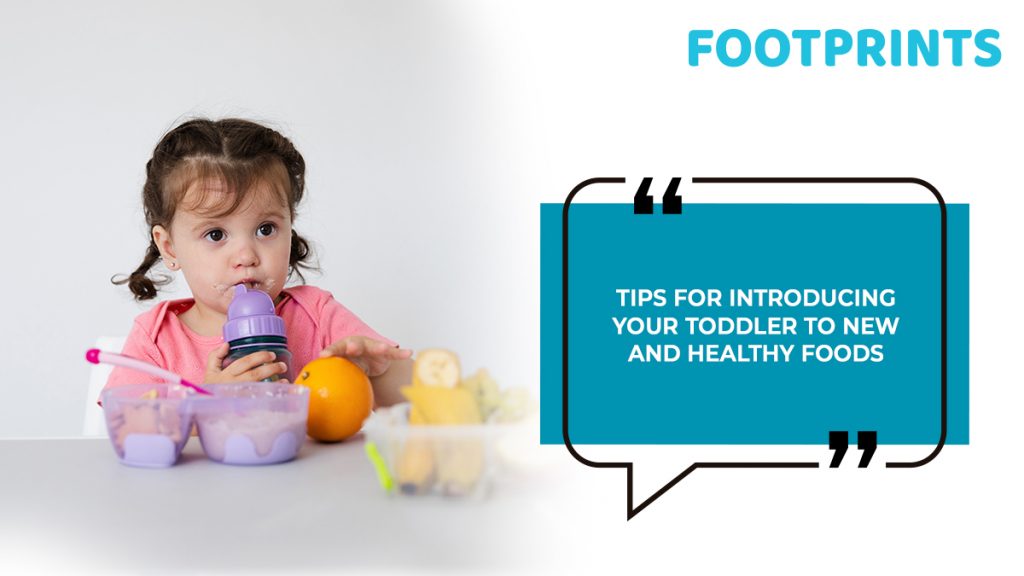
Are you having a tough time getting your toddler to try new food? While it is on every parent’s agenda to offer healthy food for kids, it does turn out to be an arduous task especially since toddlers love both their independence as well as their ritual. A change from familiar food therefore may seem a little daunting. Here are some handy tips to ensure that meal times do not become a power struggle & that you are able to offer different types of nutrition to your child.
1. Start Small
First things first! Much as you have a healthy food chart for kids along with details of the potion they need to be fed, the trick when introducing new food to your toddler is to start small. A small helping of new food is always less overwhelming for the child. A slice of apple and a spoonful of yogurt may all be great ways to get the child started.
2. Creativity is key
To get the child to try something new, you will need a little creativity, to say the least. A bowl with their favorite cartoon character, and food arranged in fun shapes is just some ideas to get the child interested. Add some fun stories into the mix and the child could take to the food. You could also look at putting together a picnic kind of setup in your living room & get the child interested in the entire experience you have on offer.

3. Involve them
It may sound easier to cook the food that you want the child to have & simply lay it on the table and ask the child to eat it. However, for a toddler who has just begun to assert his independence, it may not work well. Instead, get your toddler involved. If you want him to try a new vegetable for example, it will be a good idea to take him to the grocery store to buy the vegetable. You could then talk about how you both could cook it together. Using descriptive words about the color, flavor & more could also go a long way in garnering interest.
Offering choices to the child also works well. So while at the grocery store, you could ask the child to choose from 2 or three vegetables that you are keen to introduce. Similarly, if you want to introduce a new fruit at snack time, allow the child to choose from 2 or 3 fruits.
Their involvement will significantly increase the chances of them trying the food & taking to it!
4. New food with old favorites
It will also work well to introduce new foods along with old favorites. So broccoli could be offered with something the child is fond of, to make the adaption easier.
5. Ensure they have worked up an appetite
If you are offering a new food for dinner when the child has already had their fill of evening snacks, odds are that you will not be too successful. A new food always tends to work better when the child has worked up an appetite. This does not of course mean that you need to starve the child in order to ensure that he tries something new, but just that you may need to look at snack times carefully.
6. Take the lead
It always works better if the child sees you enjoying a certain food. They are then likely to follow your lead. So go ahead & eat together. Seeing the parent or a sibling enjoying a particular food may just be the impetus that your toddler needs.
7. Offer Variety
It is imperative to introduce the child to a variety of tastes & textures. Not only does it enable the child to get a whole variety of nutrients from different foods, but they are also likely to take to a balanced diet later in life.
8. Use a Food Bridge
Nutritionists often recommend using a food bridge. What this means is that once a child takes to a particular food, introduce other food, which has a similar flavor or texture. For example, if the child likes eating mashed sweet potatoes, you may want to introduce mashed carrots.
9. Try, try until you succeed
Children may take a while to warm up to a particular food. Just because a child has refused to eat a particular food once or twice, does not mean that he may not take to it. You, therefore, need to keep trying.
10. Do not Push
That said, try not to push the food too much. Typically the child then tries to push back & what you witness is a power struggle. Remember that children, as much as adults do not want to let go of a sense of control. Remembering this aspect will enable you to make just the right moves.
In this context, it is always helpful to remind yourself of Ellyn Satter’s “ Division of Responsibility in Feeding”. It states that in a feeding relationship, the caregiver is in charge of what, when & where the food is served & the child is in charge of how much of the food is eaten. If you remember this principle, you will not take the child’s refusal to eat, personally.

11. Bargaining does not work
How often have you said to the child that if he eats a few more bites of the green vegetable, you will give him chocolate? The problem with this is that such bargains do not work in the long run. In fact in the short run too, the child may be reminded of chocolate & may refuse to eat anything but that at that very moment. Refrain from making meal times one filled with bargaining. If anything they do not help the child form a healthy relationship with food. The same is true of threats. You do not want meal times to become times where negotiating power wins!
12. Make meal times enjoyable
Above everything, make sure that you make meal times enjoyable. You could take to creative plating, storytelling, and more. With some effort, meal times will become bonding time for you. Needless to say that it will also help the child take to the food that you have on offer.
To Sum Up
It is imperative to remember that each child is different and that there is no quick fix for a picky eater. In fact, despite our best attempts, there will be times when your toddler will refuse to eat what you offer. The key is in remaining patient and also offering repeated exposure to a particular Healthy food item.
Also while you may not like the toddler playing with food, the fact remains that if the toddler wants to touch & play with food, they may be more likely to try it.
Overall nagging them or insisting that the plate be clean isn’t likely to work. What will work though is patience & enthusiasm. Remember how in order to teach your toddler to say bye you would wave every day as you headed out? Similarly, it is your enthusiasm for a variety of food that is likely to rub on the child. Be that role model, momma, and see the child follow you! Ensuring love for healthy food for kids sure takes some time & effort, but is totally worth it!
Here’s to healthy eating….and too happy eating!



